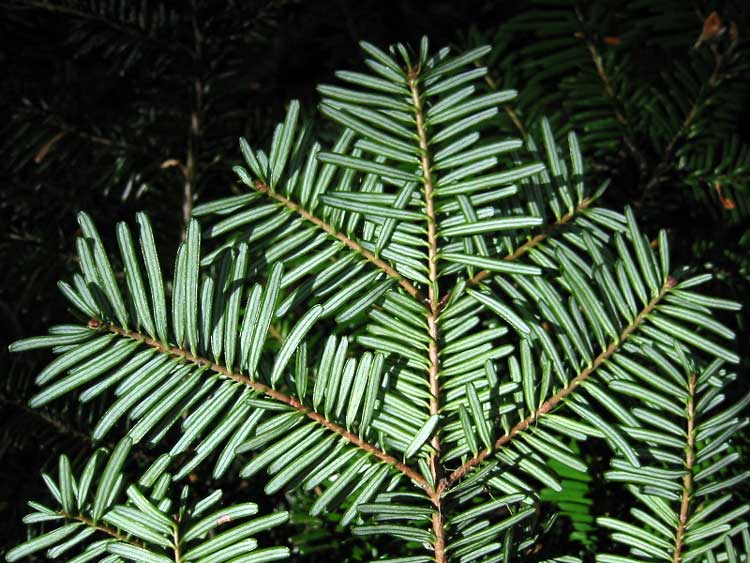Superregnum: Eukaryota
Regnum: Plantae
Divisio: Tracheophyta
Divisio: Pinophyta
Classis: Pinopsida
Ordo: Pinales
Familia: Pinaceae
Genus: Abies
Sectio: A. sect. Amabilis
Species: Abies amabilis
Name
Abies amabilis (Douglas ex Loudon) J.Forbes, Pinet. Woburn.: 125 (1839).
Synonyms
Basionym
Picea amabilis Douglas ex Loudon, Arbor. Frutic. Brit. 4: 2342 (1838).
Homotypic
Pinus amabilis (Douglas ex Loudon) Parl. in A.P.de Candolle, Prodr. 16(2): 426 (1868).
Heterotypic
Abies grandis Hook., Fl. Bor.-Amer. 2: 163 (1838), nom. illeg.
Abies grandis var. densifolia Engelm., Trans. Acad. Sci. St. Louis 3: 599 (1877).
Distribution
Native distribution areas:
Northern America
Subarctic America
Alaska
Eastern Canada
British Columbia.
Northwestern U.S.A.
Oregon, Washington.
Southwestern U.S.A
California.
References: Brummitt, R.K. 2001. TDWG – World Geographical Scheme for Recording Plant Distributions, 2nd Edition
References
Additional references
Hunt, R.S. 1993. Abies amabilis. Pp. - in Flora of North America Editorial Committee (ed.), Flora of North America North of Mexico. Volume 2: Pteridophytes and Gymnosperms. XVI, 475 p., Oxford University Press, New York, Oxford. ISBN 0-19-508242-7. efloras Reference page.
Farjon, A. 2010. A Handbook of the World's Conifers. Koninklijke Brill, Leiden. ISBN 90-04-17718-3. Reference page.
Links
Farjon, A. 2013. Abies amabilis. The IUCN Red List of Threatened Species 2013. IUCN Red List Category: Least Concern. DOI: 10.2305/IUCN.UK.2013-1.RLTS.T42271A2968657.en.
Govaerts, R. et al. 2021. Abies amabilis in World Checklist of Selected Plant Families. The Board of Trustees of the Royal Botanic Gardens, Kew. Published online. Accessed: 2021 March 4. Reference page.
International Plant Names Index. 2021. Abies amabilis. Published online. Accessed: 4 March 2021.
Vernacular names
العربية: شوح مستحب
čeština: Jedle líbezná
Deutsch: Purpur-Tanne
English: Pacific Silver Fir
Esperanto: Gracia abio
español: Abeto del Pacífico
eesti: Õilis nulg
فارسی: نراد سیمین اقیانوس آرام
suomi: Purppurapihta
français: Sapin gracieux
hrvatski: Grimizna jela
magyar: Szitka jegenyefenyő
íslenska: Silfurþinur
italiano: Abete amabile
lietuvių: Purpurinis kėnis
polski: Jodła wonna
русский: Пихта миловидная
Abies amabilis, commonly known as the Pacific silver fir, is a fir native to the Pacific Northwest of North America, occurring in the Pacific Coast Ranges and the Cascade Range. It is also commonly referred to as the white fir, red fir, lovely fir, Amabilis fir, Cascades fir, or silver fir.[2][3] The species name is Latin for 'lovely'.[2]
Description
The tree is a large evergreen conifer growing to 30–45 metres (98–148 feet), exceptionally 72 m (236 ft) tall,[2] and with a trunk diameter of up to 1.2 m (3 ft 11 in), exceptionally 2.3 m (7 ft 7 in). The bark on younger trees is light grey, thin and covered with resin blisters.[4] On older trees, it darkens and develops scales and furrows. The leaves are needle-like, flattened, 2–4.5 centimetres (3⁄4–1+3⁄4 in) long and 2 millimetres (1⁄16 in) wide by 0.5 mm (1⁄32 in) thick, matte dark green above, and with two white bands of stomata below, and slightly notched at the tip.[5] The leaf arrangement is spiral on the shoot, but with each leaf variably twisted at the base so they lie flat to either side of and above the shoot, with none below the shoot. The shoots are orange-red with dense velvety pubescence. The cones are 9–17 cm (3+1⁄2–6+3⁄4 in) long and 4–6 cm (1+1⁄2–2+1⁄4 in) broad, dark purple before maturity;[4] the scale bracts are short, and hidden in the closed cone. The winged seeds are released when the cones disintegrate at maturity about 6–7 months after pollination.
The tree can live to over 400 years old.[4]
Pacific silver fir is very closely related to Maries' fir A. mariesii from Japan, which is distinguished by its slightly shorter leaves—1.5–2.5 cm (5⁄8–1 in)—and smaller cones, which are 5–11 cm (2–4+1⁄4 in) long.
Distribution and ecology
The species is native to the Pacific Northwest of North America, occurring in the Pacific Coast Ranges and the Cascade Range from the extreme southeast of Alaska, through western British Columbia, Washington and Oregon, to the extreme northwest of California. It grows from sea level to 1,500 m (4,900 ft) in the north of the range, and to 1,000–2,300 m (3,300–7,500 ft) in the south of the range.
It is always found in temperate rainforests with relatively high precipitation and cool, humid summers. Growing in dense stands, it prospers in shade and snow.[4] Common associate trees are western hemlock in northern ranges, Douglas-fir[4] in central areas, and California buckeye in the extreme southern area of its range.[6] Western hemlock is equally shade tolerant, but Pacific silver fir saplings are more resilient of ground obstacles.[4] Though its thin bark makes it susceptible to fire, the slow-growing saplings succeed less shade-tolerant species.[4] It survives well at high elevation, but eventually succumbs to root or heart rot, in addition to diseases and insects such as Adelges piceae.[4]
Uses
Native Americans utilized the species for medicinal purposes.[4] After David Douglas discovered it in 1825, he brought seeds to England for cultivation.[4]
The wood is soft and not very strong; it is used for paper making, packing crates and other cheap construction work.[4] The lumber is often paired with that of western hemlock.[4] The foliage has an attractive scent and is sometimes used for Christmas decoration, including Christmas trees.
It is also planted as an ornamental tree in large parks, though its requirement for cool, humid summers limits the areas where it grows well; successful growth away from its native range is restricted to areas like western Scotland and southern New Zealand.
References
Farjon, A. (2013). "Abies amabilis". IUCN Red List of Threatened Species. 2013: e.T42271A2968657. doi:10.2305/IUCN.UK.2013-1.RLTS.T42271A2968657.en. Retrieved 19 November 2021.
"Abies amabilis". Gymnosperm Database. 2011. Retrieved December 3, 2021. "The epithet amabilis means 'lovely."
Interactive Distribution Map of Abies amabilis
Arno, Stephen F.; Hammerly, Ramona P. (2020) [1977]. Northwest Trees: Identifying & Understanding the Region's Native Trees (field guide ed.). Seattle: Mountaineers Books. pp. 123–128. ISBN 1-68051-329-X. OCLC 1141235469.
Flora of North America (2008) Vol. 2: Pinaceae
C. Michael Hogan (2008) Aesculus californica, Globaltwitcher.com, ed. N. Stromberg
Retrieved from "http://en.wikipedia.org/"
All text is available under the terms of the GNU Free Documentation License


